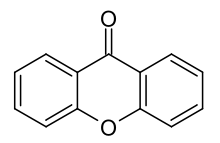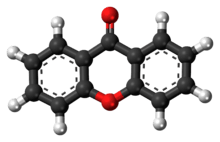Xanthone
Xanthone is an organic compound with the molecular formula C13H8O2. In 1939, xanthone was introduced as an insecticide and it currently finds uses as ovicide for codling moth eggs and as a larvicide.[2] Xanthone is also used in the preparation of xanthydrol, which is used in the determination of urea levels in the blood.[3] It can also be used as a photocatalyst.[4]
 | |
 | |
| Names | |
|---|---|
| IUPAC name
9H-Xanthen-9-one | |
| Other names
9-Oxoxanthene Diphenyline ketone oxide | |
| Identifiers | |
3D model (JSmol) |
|
| ChEBI | |
| ChEMBL | |
| ChemSpider | |
| ECHA InfoCard | 100.001.816 |
PubChem CID |
|
| UNII | |
CompTox Dashboard (EPA) |
|
| |
| |
| Properties | |
| C13H8O2 | |
| Molar mass | 196.205 g·mol−1 |
| Appearance | Off-white solid |
| Melting point | 174 °C (345 °F; 447 K) |
| Sl. sol. in hot water | |
| -108.1·10−6 cm3/mol | |
| Hazards | |
| R-phrases (outdated) | R36/37/38 |
| S-phrases (outdated) | S26 S37[1] |
| Related compounds | |
Related compounds |
xanthene |
Except where otherwise noted, data are given for materials in their standard state (at 25 °C [77 °F], 100 kPa). | |
| Infobox references | |
Xanthone derivatives
The chemical structure of xanthone forms the central core of a variety of naturally occurring organic compounds, such as mangostin, which are sometimes collectively referred to as xanthones or xanthonoids. Over 200 xanthones have been identified. Many xanthones are phytochemicals found in plants in the families Bonnetiaceae, Clusiaceae, Podostemaceae, and others.[6] They are also found in some species of the genus Iris.[7] Some xanthones are found in the pericarp of the mangosteen fruit (Garcinia mangostana) as well as in the bark and timber of Mesua thwaitesii.[8]
See also
References
- MSDS from AlphaAesarArchived September 27, 2007, at the Wayback Machine
- Steiner, L. F. and S. A. Summerland. 1943. Xanthone as an ovicide and larvicide for the codling moth. Journal of Economic Entomology 36, 435-439.
- Bowden, R. S. T. (1962). "The Estimation of Blood Urea by the Xanthydrol Reaction". Journal of Small Animal Practice. 3 (4): 217–218. doi:10.1111/j.1748-5827.1962.tb04191.x.
- Romero, Nathan A.; Nicewicz, David A. (10 June 2016). "Organic Photoredox Catalysis". Chemical Reviews. 116 (17): 10075–10166. doi:10.1021/acs.chemrev.6b00057. PMID 27285582.
- Organic Syntheses, Coll. Vol. 1, p.552 (1941) - preparation of xanthone
- "An update of the Angiosperm Phylogeny Group classification for the orders and families of flowering plants: APG II". Botanical Journal of the Linnean Society. 141 (4): 399–436. 2003. doi:10.1046/j.1095-8339.2003.t01-1-00158.x.
- Williams, C.A; Harborne, J.B.; Colasante, M. (2000). "The pathway of chemical evolution in bearded iris species based on flavonoid and xanthone patterns" (PDF). Annali di Botanica. 58: 51–54. Retrieved 28 October 2015.
- Bandaranayake, Wickramasinghe M.; Selliah, Sathiaderan S.; Sultanbawa, M.Uvais S.; Games, D.E. (1975). "Xanthones and 4-phenylcoumarins of Mesua thwaitesii". Phytochemistry. 14: 265–269. doi:10.1016/0031-9422(75)85052-7.
